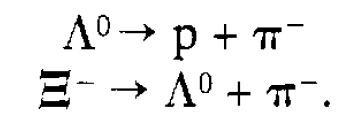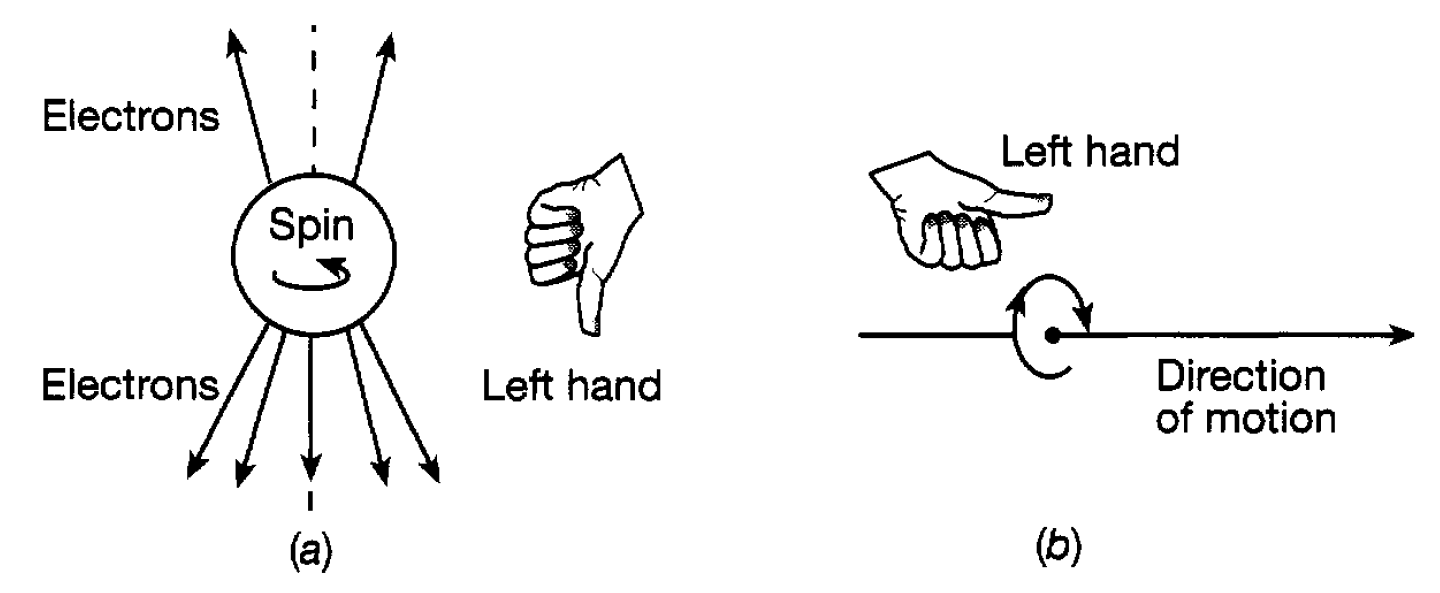


 الفيزياء الكلاسيكية
الفيزياء الكلاسيكية
 الكهربائية والمغناطيسية
الكهربائية والمغناطيسية
 علم البصريات
علم البصريات
 الفيزياء الحديثة
الفيزياء الحديثة
 النظرية النسبية
النظرية النسبية
 الفيزياء النووية
الفيزياء النووية
 فيزياء الحالة الصلبة
فيزياء الحالة الصلبة
 الليزر
الليزر
 علم الفلك
علم الفلك
 المجموعة الشمسية
المجموعة الشمسية
 الطاقة البديلة
الطاقة البديلة
 الفيزياء والعلوم الأخرى
الفيزياء والعلوم الأخرى
 مواضيع عامة في الفيزياء
مواضيع عامة في الفيزياء|
Read More
Date: 11-4-2017
Date: 27-3-2017
Date: 27-4-2017
|
The Weak Interaction
The discussion so far in this chapter has been essentially about the structure and behaviour of the many varieties of hadron. Their quark structure is determined by quantum chromodynamics which is the basic theory of the strong interaction. As has been stressed, strong interactions satisfy all the conservation laws we have so far encountered and strong interaction processes, exemplified by the production of new elementary particles in accelerator experiments, are very fast and prolific. They typically happen in times of the order 10-23s. Very heavy hadrons, created in such experiments, only live for times of this same order of magnitude. They decay by means of the strong interaction into lighter hadrons, the decay processes always obeying all conservation laws. However, lighter hadrons such as the Λ-, Σ-, π- and K-particles have no lighter particles to which they can decay without violating one or other conservation law and they live for much longer times around 10-l0-l0-8 s-apart from those decays involving photons (γ) when the mean lives are much shorter. The latter arise from the electromagnetic interaction and the former, much slower processes, are due to the weak interaction. Weak interaction decay processes manifest themselves in three forms.
Leptonic Decays. These are processes which only involve leptons such as

This process is rather like the prototype beta decay process except that it only involves leptons. Here it should be noted that both types of neutrino are generally assumed to have very small, if not zero, mass.
Semi leptonic Decays. These are processes such as beta decay which involve both hadrons and leptons. Examples are

Strangeness is conserved in the first two processes but not in the third. The weak interaction allows both strangeness conserving and strangeness non conserving semi leptonic processes to take place. The semi leptonic process

can also take place and is important in understanding the formation of neutron stars.
Non leptonic Decays. These are processes not involving leptons such as

In all such processes the law of conservation of strangeness is violated and the strangeness always changes by ±1. The foregoing examples are just a few from the very many hundreds of observed weak decay processes in the three categories. They all involve the violation of one or more of the conservation laws which govern strong interaction processes and here we come to another very important violation namely the non-conservation of parity. Until 1956 physicists had always assumed that the nature of the physical world was such that the mirror image of any physical process was also allowed in the real world. Watch the everyday world through a mirror and everything that is seen to take place could happen in the real world. Of course, there would be ‘giveaways’ lettering would be wrong for example. But our alphabet is only a matter of convention and the fact that it looks different through a mirror is nothing to do with the underlying laws of physics. Similarly our left hand observed through a mirror appears as a right hand but the mirror image person still obeys the basic laws of physics. It had always been assumed that there was no fundamental physical process or interaction which was intrinsically left or right handed. If there had been then its mirror image would have had the opposite handedness and would not therefore ever be seen in the real world. In other words the laws of physics were assumed to be invariant under mirror reflection. As we invariance under a process always leads to something being conserved. In this case the ‘something’ is referred to as parity which can either be even (+) or odd (-). Roughly speaking something with odd parity changes sign when studied through a mirror (a left handed screw becomes a right handed screw) whilst something with even parity remains the same (for example, a dumb bell). All elementary particles have a definite parity and it follows that, if parity is conserved, all particle processes are such that the product (parity is not an additive conservation law) of the parities at the end of a process is the same as at the outset. In the 1950s a difficulty had arisen in understanding the K+ meson which was observed to decay sometimes into two pions and sometimes into three. Pions have odd parity and therefore two together have even parity (-1 × -1 = +1) whilst three have odd parity (-1 × -1 × -1 = -1) so that since the K+ has odd parity the two pion decay does not conserve parity. T D Lee and C N Yang (1957 Nobel Laureates) suggested that the problem could be resolved if the weak interaction in this process, and in general, did not conserve parity. This meant that weak interaction processes would exhibit a ‘handedness’ and it was suggested that such handedness might be observed in the well-known beta decay process. In 1957 an experimental study of the way in which electrons are emitted from spinning radioactive nuclei (cobalt-60) was undertaken by C S Wu and her collaborators in the USA. She cooled an assembly of cobalt nuclei down to around 0.01 K so that they were hardly affected by thermal vibrations and their spins could then be aligned to point in the same direction by a powerful magnetic field (see figure 1.1(a)). It was found that the electrons were emitted mainly in the downwards direction, implying that the whole process was left-handed in nature as illustrated. In other words, if curled fingers indicate the direction of spin and the thumb the preferred direction of electron emission, then the left hand must be used to agree with experiment. Further experiments also established that neutrinos in beta decay were always emitted spinning in a left handed way about their direction of motion like a rifle bullet (see figure 1.1(b)). Right-handed neutrinos are never observed although, as might be expected, antineutrinos are right handed. This handedness or, in turn, non-conservation of parity is now well established to be characteristic of all weak interaction processes, but strong and electromagnetic processes all conserve parity and any small non-conservation observed in them can always be attributed to slight modifications of the process by the weak interaction. In this context it is interesting to note that in 1964 another related invariance principle was found to be violated in the decay of the  . The
. The  and the
and the  and are different combinations of the K0 and its antiparticle (
and are different combinations of the K0 and its antiparticle ( ).This mixing arises because the weak interaction allows the K0 and the
).This mixing arises because the weak interaction allows the K0 and the  to convert backwards and forwards into one another. The
to convert backwards and forwards into one another. The  always decays into two pions whilst the
always decays into two pions whilst the  usually decays into three pions but just occasionally into two. Detailed theoretical analysis shows that this latter behaviour implies that there must exist a very weak interaction which is not invariant under the reversal of time. Up to this date it had been assumed that the basic laws of elementary particle physics were all invariant under time reversal. Thus, if a video was made of any elementary particle process and it was run backwards, then the observed time-reversed process would also be an allowable elementary particle process. Here it must be
usually decays into three pions but just occasionally into two. Detailed theoretical analysis shows that this latter behaviour implies that there must exist a very weak interaction which is not invariant under the reversal of time. Up to this date it had been assumed that the basic laws of elementary particle physics were all invariant under time reversal. Thus, if a video was made of any elementary particle process and it was run backwards, then the observed time-reversed process would also be an allowable elementary particle process. Here it must be

Figure 1.1: Parity non-conservation in beta-decay: (a) electron distribution; (b) neutrino spin.
stressed that this invariance does not hold for complex physical phenomena such as steam pouring out of a kettle the time reversed process of steam rushing back into the spout would not be seen in the real world. This latter irreversibility relates to the statistical nature of complex systems and the second law of thermodynamics and not from time reversal non invariance of the interactions between basic particles. Much experimental work has been targeted at finding other examples of time reversal non-invariance. In particular it is predicted that the neutron should behave as though it had a small amount of positive electric charge at one end of its spin and an equal amount of negative charge at the other end rather like the north and south poles of a magnet. The predicted effect is, however, very small and so far (1996) has not been detected. The weak interaction is clearly complicated, not only because of the way in which it violates various conservation laws but also because of the many different types and combinations of particle involved in its manifestation. The next task is to describe how it has now become well understood in terms of an impressive fundamental theory.



|
|
|
|
"عادة ليلية" قد تكون المفتاح للوقاية من الخرف
|
|
|
|
|
|
|
ممتص الصدمات: طريقة عمله وأهميته وأبرز علامات تلفه
|
|
|
|
|
|
|
المجمع العلمي للقرآن الكريم يقيم جلسة حوارية لطلبة جامعة الكوفة
|
|
|